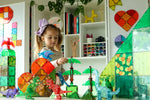
Why Magna-Tiles Are More Than Just Toys: A Parent’s Guide to Meaningful Play
, by Jack Jones, 5 min reading time

, by Jack Jones, 5 min reading time
Walk into any playroom and you’ll find shelves full of toys—some with flashing lights, some with sound effects, and some that promise to “teach your child everything they need to know by age 5.” But amid the noise and clutter, there’s one toy that keeps earning its place in homes, classrooms, and therapy centers across the world: Magna-Tiles.
At first glance, they’re simple—colorful, geometric tiles that click together with magnets. No batteries. No screens. No preset storylines. But that simplicity is exactly what makes them powerful. Magna-Tiles invite children into a world of creativity, exploration, and growth. And that’s what makes them perfect for meaningful play.
So what is meaningful play—and why does it matter so much?
Meaningful play isn’t just about passing time. It’s a form of hands-on learning that allows kids to process the world around them. It helps them solve problems, express emotions, test ideas, and engage in self-directed discovery. It’s the kind of play that sticks with them long after the pieces are packed away.
Magna-Tiles naturally support this type of deep engagement. While they may look like just another building toy, they quietly reinforce the core components of child development across cognitive, emotional, and social domains.
Let’s take a closer look at why Magna-Tiles deserve a spot in every child's life.
A child with a set of Magna-Tiles is a child in control. There are no instructions, no required outcomes—just open-ended pieces and the freedom to explore. In one moment, a child might build a spaceship. In the next, they’re crafting a zoo or a maze for their favorite toys. The play is directed entirely by their imagination, which builds creativity and confidence.
This freedom of choice fosters a powerful sense of agency. Children learn to trust their ideas, follow their curiosity, and think beyond limits. That’s the kind of creative thinking that translates into innovation later in life.
Parents often ask how to introduce young kids to STEM (Science, Technology, Engineering, and Math) without turning playtime into a classroom. Magna-Tiles are the answer. When children snap together triangles and squares, they’re learning geometry. When they build a tower and adjust it to stop it from falling, they’re doing physics. When they pattern shapes by color or symmetry, they’re using early math skills.
And they’re doing all of this joyfully—without worksheets, lectures, or pressure.
Magna-Tiles give children a chance to experience concepts that often feel abstract. They’re not just being told about shapes and structures—they’re creating and manipulating them with their own hands.
Some toys are great for a few months, then forgotten. Magna-Tiles, on the other hand, evolve with your child. Toddlers begin with basic stacking and color recognition. Preschoolers move into building towers, houses, or trains. Elementary-age kids start constructing detailed, imaginative worlds with windows, symmetry, and moving parts.
The play changes, but the tiles remain the same. That makes them not only versatile but also a smart, sustainable choice for long-term development.
There’s something quietly captivating about building with Magna-Tiles. The soft clicking of magnets, the slow satisfaction of a growing structure, the gentle problem-solving rhythm—it all creates a surprisingly calming experience.
Many parents notice that Magna-Tiles become their child's go-to activity when they need a break from overstimulation. It’s screen-free, open-ended, and focused. In a world where attention spans are shrinking, Magna-Tiles offer an antidote: a toy that actually encourages concentration and mindfulness.
Magna-Tiles are ideal for independent play, but they’re just as valuable in group settings. Whether it’s siblings, classmates, or parents joining in, kids naturally begin working together: negotiating what to build, dividing tasks, offering ideas, and solving problems as a team.
This collaboration fosters communication, empathy, and leadership. It teaches kids how to work toward a shared goal, handle disappointment, and celebrate one another’s ideas. These are skills that go far beyond the playroom.
When a child builds a towering castle, only to watch it collapse, it can be frustrating. But every fall is an opportunity. Magna-Tiles teach kids that failure is part of the process—that trying again is a normal (and even fun) part of learning.
Over time, this type of play builds resilience. Kids learn that effort matters, that mistakes aren’t the end, and that patience pays off. It’s a playful lesson in persistence—and it’s one they’ll carry for life.
Add a few animal figures or action figures into the mix, and Magna-Tiles become the backdrop for storytelling. Suddenly, that pyramid is a dragon’s cave. The tower is a rescue base. The train they built has a secret mission.
Children begin developing rich narratives, complete with characters, conflicts, and resolutions. These stories not only build language and literacy skills—they help children process emotions, understand the world around them, and rehearse real-life scenarios in a safe, imaginative space.
Magna-Tiles may not talk, flash, or dance—but that’s precisely the point. They don’t tell children what to think or how to play. Instead, they give children the tools to think for themselves, to build with purpose, and to discover joy in their own ideas.
That’s the heart of meaningful play.
So the next time you see your child completely immersed in a Magna-Tiles creation—eyes focused, mind turning, hands at work—know that it’s not just fun. It’s the foundation of learning, confidence, and imagination being quietly built, one magnetic tile at a time.